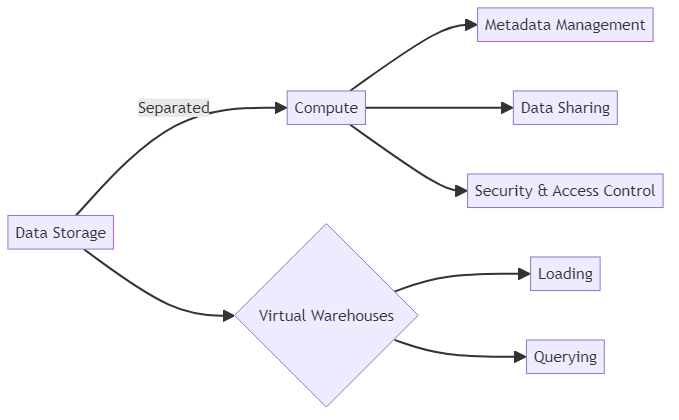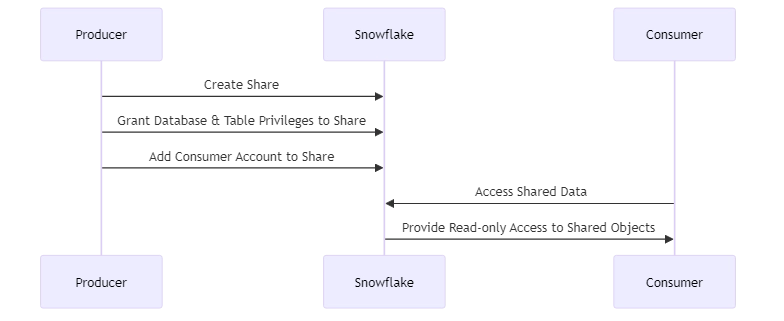
Snowflake’s Data Management Capabilities

Introduction
Data is the lifeblood of modern organizations. Effectively managing, analyzing, and deriving insights from data is critical for making informed business decisions, improving operational efficiency, and driving innovation. Snowflake, a cloud-based data warehousing and analytics platform, has revolutionized the way organizations handle their data. This article will cover the basics of Snowflake data management, including its main features, advantages, and recommended practices.
What is Snowflake?
Snowflake is a tool for storing and analyzing large amounts of data in the cloud. It helps organizations manage structured and semi-structured data effectively.
Snowflake designers have made it highly scalable, flexible, and cost-effective, unlike traditional on-premises data warehouses. It separates compute from storage, allowing users to scale resources independently based on their workload requirements.
Some key features of Snowflake include:
- Built for the cloud: Snowflake is a true cloud-native platform, enabling seamless scaling and high availability.
- Data sharing: Snowflake allows organizations to securely share live, governed data across regions, clouds, and organizations.
- Support for diverse data: Snowflake can handle structured, semi-structured (JSON, Avro, XML), and unstructured data (via external tables).
- SQL compatibility: Snowflake is user-friendly for those who know SQL.
Defining Data Management
Before diving into Snowflake data management specifics, let’s define what we mean by data management. Data management includes collecting, storing, protecting, and processing data. The goal is to ensure that the data is easily accessible, reliable, and delivered on time for users.
Effective data management is crucial for organizations looking to derive value from their data assets.
Key aspects of data management include:
- Data governance: Establishing policies, procedures, and standards to ensure data quality, security, and compliance.
- Data integration: Combining data from multiple sources to provide a unified view.
- Data security: Protecting data from unauthorized access, corruption, and loss.
- Data lifecycle management: Managing data from creation to archival and deletion.
- Metadata management: Capturing and managing information about data, such as its structure, origin, and usage.
Data Management in Snowflake
Snowflake provides a comprehensive set of features and tools to simplify data management. Let’s explore some of the key aspects of data management in Snowflake.
Data Storage and Organization
Snowflake uses a unique architecture that separates compute from storage.

Snowflake architecture example
The cloud stores data, such as Amazon S3, Azure Blob Storage, or Google Cloud Storage. We optimized, compressed, and organized the data to make searching more efficient. Snowflake organizes data into databases, schemas, and tables, similar to traditional relational databases.
For example, to create a new database and table in Snowflake, you would use the following SQL commands:
CREATE DATABASE my_database; USE my_database; CREATE TABLE users ( id NUMBER, name STRING, email STRING );
Data Loading and Integration
Snowflake can load data in various ways. It can load data from files such as CSV, JSON, and Avro. It can also load data from streaming sources like Kafka and Kinesis.
Additionally, Snowflake can load data from external tables that have data stored in cloud storage. Snowflake optimizes its data loading process for performance and can handle petabytes of data.
For instance, to load data from a CSV file into a Snowflake table, you would use the COPY INTO command:
COPY INTO users FROM 's3://my-bucket/users.csv' FILE_FORMAT = (TYPE = CSV);
When you run this command, it loads the data from the CSV file into the users table. This will allow you to query and analyze the data.
Data Security and Access Control
Snowflake provides robust security features to protect data at rest and in transit. It automatically encrypts all data using industry-standard encryption algorithms. Snowflake allows administrators to control access to objects and actions by assigning permissions based on user roles. Role-based access control (RBAC) accomplishes this.
Here’s an example of creating a role and granting privileges:
CREATE ROLE analyst; GRANT USAGE ON DATABASE my_database TO ROLE analyst; GRANT SELECT ON TABLE my_database.public.users TO ROLE analyst;
In this example, a analyst has access to use the my_database database. They can also view the users table by granting them SELECT privileges. Users assigned the analyst role would then be able to query the users table.
Data Sharing and Collaboration
One of Snowflake’s most powerful features is its data sharing capabilities. Snowflake helps organizations share data securely across regions, clouds, and organizations without moving the data. Snowflake’s unique architecture enables data sharing by separating compute from storage.

To share data in Snowflake, you create a share object that contains the database objects you want to share. You can then grant the share to other Snowflake accounts, enabling them to access the shared data in real-time.
Here’s an example of creating a share and granting access:
CREATE SHARE my_share; GRANT USAGE ON DATABASE my_database TO SHARE my_share; GRANT SELECT ON TABLE my_database.public.users TO SHARE my_share; ALTER SHARE my_share ADD ACCOUNTS = <consumer_account_id>;
In this example, we create a share named my_share. We give usage privileges on the my_database database and SELECT privileges on the users table to the share. We then add a consumer account to the share, allowing them to access the shared data.
Best Practices for Snowflake Data Management
To make the most of Snowflake’s data management capabilities, consider the following best practices:
- Develop a clear data governance strategy that includes policies for data quality, security, and access control.
- Leverage Snowflake’s role-based access control (RBAC) to ensure that users have access only to the data they need.
- Use Snowflake’s data sharing to securely share data with internal and external stakeholders, reducing data silos and enabling collaboration.
- Implement a data lifecycle management process to archive and delete data properly when no longer needed.
- Monitor and optimize query performance using Snowflake’s built-in tools, such as the Query Profile and the Query History.
Conclusion
Snowflake data management provides organizations with a powerful, flexible, and scalable platform for storing, managing, and analyzing data.
Organizations can fully utilize their data potential by using Snowflake’s special architecture, data sharing abilities, and strong security features.
As data continues to grow in volume, variety, and velocity, effective data management will become increasingly critical for organizations looking to stay competitive.
Snowflake’s data management is cloud-based. It can adjust to variations in data. This makes it a solution that is future-ready.
